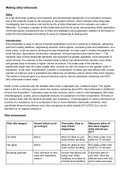Making ethyl ethanoate
Aims
As a lab technician working in the research and development department of a cosmetics company,
one of the products made by the company is nail polish remover, which contains ethyl ethanoate,
Investigating how to produce and test the purity of ethyl ethanoate so the company can make it
efficiently. To prepare a sample of ethyl ethanoate and test its purity, demonstrating skilful application
of the techniques, including the use of reflux and distillation using apparatus, addition of chemicals to
purify the ethyl ethanoate and testing its purity by measuring its boiling point.
Introduction
Ethyl ethanoate is used in various industrial applications such as in paints as a hardener, adhesives,
paint and coating additives, degreasing solvents, active agents, processing aids and plasticisers. At a
lower purity, it can be used in printing and pharmaceuticals. It is also used in coating formulations for
wood furniture, agricultural, construction equipment, mining equipment and marine uses [1] . The
industrial uses of ethyl ethanoate generally use equipment at greater quantities, more advanced (if
used correctly, the chances of the substance that is being manufactured that impurity is less likely)
and greater sizes to develop a higher volume of product, The scale used in the industry is
significantly larger than the scale smaller labs, schools etc use, the reason for the greater scale of
equipment, In the main “esterification” process, a combination of acetic acid and ethanol with a small
quantity of sulphuric acid is preheated and added into an eterifing column where reflux then happens,
The solution removed goes to a second refluxing column, ternary azeotrope containing over 85%
ethyl ethanoate is taken away.
Water is then combined with the distillate after which it separates into 2 different layers. The higher
layer is fed to a refluxing column which the residue containing about 90% ethyl ethanoate is distilled to
remove any impurities[2]. Laboratory uses include mixtures used in column chromatography (thin layer
chromatography, usually used to separate mixtures of substances into their components. All forms of
this method work with the identical principle) and extractions. Chromatography is used to provide proof
of purity of a substance. As it is composed of two or more elements chemically combined, most
specifically ethanol and ethanoic acid, also recognized as ethyl acetate (CH3COOC2H5), can be
identified as its original compound.
Risk assessment
Risk (the danger) Hazard (what could Prevention (how to Measures taken (if
go wrong?) stop if from this does happen,
happening) what should you
do?)
Hot flask Burns Allow for flask to cool Run flask under cold
down before handling water for 10 minutes
Hot glass Burns Allow for glass to cool Run glass under cold
down before handling water for 10 minutes
Bumping granules Very corrosive to skin, Ensure that gloves are If granules gets on
eyes and respiratory being worn while your skin, rinse the
system handling, and allow for affected area with luck
minimal time handling warm water and soap
, for at least 10-15
minutes and seek
medical advice
Electric heating mantle Burns Allow for device to cool Run hands under cold
before handling or water for 10 minutes
storing
Ethanoic acid Very corrosive Ensure that gloves and If this chemical gets on
goggles are worn your skin, rinse the
affected area with luck
warm water and soap
for at least 10-15
minutes and seek
medical advice
Concentrated acids Very corrosive Ensure that gloves and If this chemical gets on
(sulfuric acid) goggles are worn your skin, rinse the
affected area with luck
warm water and soap
for at least 10-15
minutes and seek
medical advice
Reflux boiling Burns Allow for this Run hand under cold
equipment to cool water for 10 minutes
down
Slips/trips/falls Chemical substances Ensure that hair is tied If this chemical gets on
may fall onto someone back out of the face, your skin, rinse the
gloves and goggles affected area with luck
are worn, Stand up warm water and soap
and tuck chair in for at least 10-15
minutes and seek
medical advice
Preparation of an ester (ethyl ethanoate)
An ester is an organic compound formed by a condensation reaction between an organic acid with an
alcohol. This method will prepare and isolate an ester, ethyl
ethanoate, by reacting under acidic conditions:
CH3COOH + CH3CH2OH -------H2SO4-------->CH3CO2CH2CH3+H2O
Reactants: Ethanoic acid+ethanol
Products: Ethyl ethanoate+water
The preparation is completed in 2 parts
1. The reactants are heated together under reflux so that any
material that evaporates is condensed and returns to the
mixture.
2. The mixture is then distilled to isolate the product
Method - part 1: heating the reaction mixture




